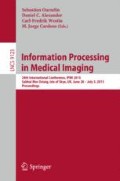Abstract
We propose a novel method to simultaneously trace brain white matter (WM) fascicles and estimate WM microstructure characteristics. Recent advancements in diffusion-weighted imaging (DWI) allow multi-shell acquisitions with b-values of up to 10,000 \(\mathrm{s/mm^2}\) in human subjects, enabling the measurement of the ensemble average propagator (EAP) at distances as short as 10 \(\mathrm{\mu m}\). Coupled with continuous models of the full 3D DWI signal and the EAP such as Mean Apparent Propagator (MAP) MRI, these acquisition schemes provide unparalleled means to probe the WM tissue in vivo. Presently, there are two complementary limitations in tractography and microstructure measurement techniques. Tractography techniques are based on models of the DWI signal geometry without taking specific hypotheses of the WM structure. This hinders the tracing of fascicles through certain WM areas with complex organization such as branching, crossing, merging, and bottlenecks that are indistinguishable using the orientation-only part of the DWI signal. Microstructure measuring techniques, such as AxCaliber, require the direction of the axons within the probed tissue before the acquisition as well as the tissue to be highly organized. Our contributions are twofold. First, we extend the theoretical DWI models proposed by Callaghan et al. to characterize the distribution of axonal calibers within the probed tissue taking advantage of the MAP-MRI model. Second, we develop a simultaneous tractography and axonal caliber distribution algorithm based on the hypothesis that axonal caliber distribution varies smoothly along a WM fascicle. To validate our model we test it on in-silico phantoms and on the HCP dataset.
Access this chapter
Tax calculation will be finalised at checkout
Purchases are for personal use only
References
Alexander, D.C., Hubbard, P.L., Hall, M.G., Moore, E.A., Ptito, M., Parker, G.J., Dyrby, T.B.: Orientationally invariant indices of axon diameter and density from diffusion MRI. NImg 42, 1374–1389 (2010)
Assaf, Y., Basser, P.J.: Composite hindered and restricted model of diffusion (CHARMED) MR imaging of the human brain. NImg 27(1), 48–58 (2005)
Assaf, Y., Blumenfeld-Katzir, T., Yovel, Y., Basser, P.J.: AxCaliber: a method for measuring axon diameter distribution from diffusion MRI. MRM 59, 1347–1354 (2008)
Assaf, Y., Freidlin, R.Z., Rohde, G.K., Basser, P.J.: New modeling and experimental framework to characterize hindered and restricted water diffusion in brain white matter. MRM 52, 965–978 (2004)
Basser, P.J., Pajevic, S., Pierpaoli, C., Duda, J., Aldroubi, A.: In vivo fiber tractography using DT-MRI data. MRM 44, 625–632 (2000)
Callaghan, P.: Pulsed-Gradient Spin-Echo NMR for planar, cylindrical, and spherical pores under conditions of wall relaxation. J. Magn. Reson. Series A 13, 53–59 (1995)
Caruyer, E., Daducci, A., Descoteaux, M., Houde, J.C., Thiran, J.P., Verma, R.: Phantomas: a flexible software library to simulate diffusion MR phantoms. In: International Symposium on Magnetic Resonance in Medicine (2014)
Close, T.G., Tournier, J.D., Calamante, F., Johnston, L.A., Mareels, I., Connelly, A.: A software tool to generate simulated white matter structures for the assessment of fibre-tracking algorithms. NImg 47(4), 1288–1300 (2009)
Daducci, A., Dal Palu, A., Alia, L., Thiran, J.P.: COMMIT: convex optimization modeling for micro-structure informed tractography. IEEE Trans. Med. Imaging 34, 246–257 (2014)
McNab, J.A., Edlow, B.L., Witzel, T., Huang, S.Y., Bhat, H., Heberlein, K., Feiweier, T., Liu, K., Keil, B., Cohen-Adad, J., Tisdall, M.D., Folkerth, R.D., Kinney, H.C., Wald, L.L.: The human connectome project and beyond: initial applications of 300 mT/m gradients. NImg 80, 234–245 (2013)
Özarslan, E., Koay, C.G., Shepherd, T.M., Komlosh, M.E., İrfanoğlu, M.O., Pierpaoli, C., Basser, P.J.: Mean apparent propagator (MAP) MRI: a novel diffusion imaging method for mapping tissue microstructure. NImg 78, 16–32 (2013)
Ritchie, J.M.: On the relation between fibre diameter and conduction velocity in myelinated nerve fibres. In: Proceedings of the Royal Society of London. Series B, Containing papers of a Biological character. Royal Society (Great Britain) 217(1206), 29–35 (1982)
Setsompop, K., Kimmlingen, R., Eberlein, E., Witzel, T., Cohen-Adad, J., McNab, J., Keil, B., Tisdall, M., Hoecht, P., Dietz, P., Cauley, S., Tountcheva, V., Matschl, V., Lenz, V., Heberlein, K., Potthast, A., Thein, H., Horn, J.V., Toga, A., Schmitt, F., Al, E.: Pushing the limits of in vivo diffusion MRI for the human connectome project. NImg 80, 220–233 (2013)
Sherbondy, A.J., Rowe, M.C., Alexander, D.C.: MicroTrack: an algorithm for concurrent projectome and microstructure estimation. In: International Conference on Medical Image Computing and Computer-Assisted Intervention, pp. 183–190 (2010)
Tournier, J.D., Calamante, F., Connelly, A.: MRtrix: diffusion tractography in crossing fiber regions. Int. J. Imaging Syst. Technol. 22(1), 53–66 (2012)
Tristán-Vega, A., Westin, C.F., Aja-Fernández, S.: Estimation of fiber orientation probability density functions in high angular resolution diffusion imaging. NImg 47, 638–650 (2009)
Tuch, D.: Q-ball imaging. MRM 52, 1358–1372 (2004)
Acknowledgments
Human brain data were provided by the Human Connectome Project (HCP; Principal Investigators: Bruce Rosen, M.D., Ph.D., Arthur W. Toga, Ph.D., Van J. Weeden, MD). HCP funding was provided by the National Institute of Dental and Craniofacial Research, the National Institute of Mental Health, and the National Institute of Neurological Disorders and Stroke.
Author information
Authors and Affiliations
Corresponding author
Editor information
Editors and Affiliations
Rights and permissions
Copyright information
© 2015 Springer International Publishing Switzerland
About this paper
Cite this paper
Girard, G., Fick, R., Descoteaux, M., Deriche, R., Wassermann, D. (2015). AxTract: Microstructure-Driven Tractography Based on the Ensemble Average Propagator. In: Ourselin, S., Alexander, D., Westin, CF., Cardoso, M. (eds) Information Processing in Medical Imaging. IPMI 2015. Lecture Notes in Computer Science(), vol 9123. Springer, Cham. https://doi.org/10.1007/978-3-319-19992-4_53
Download citation
DOI: https://doi.org/10.1007/978-3-319-19992-4_53
Published:
Publisher Name: Springer, Cham
Print ISBN: 978-3-319-19991-7
Online ISBN: 978-3-319-19992-4
eBook Packages: Computer ScienceComputer Science (R0)

